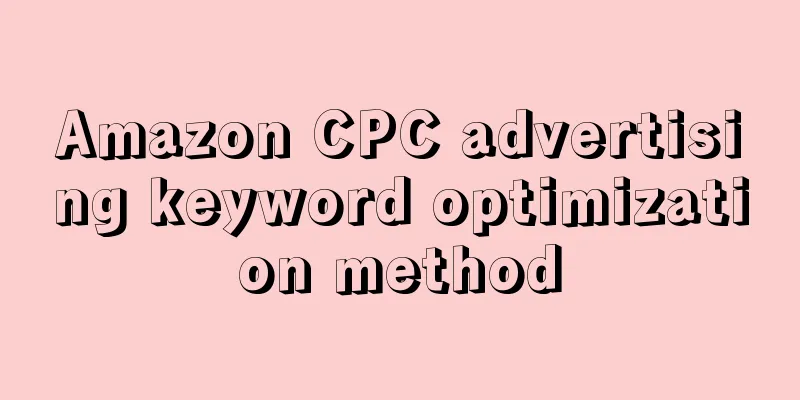Today we will learn about Amazon CPC advertising keyword optimization methods!
Rules for ad ranking
Although CPC booths are limited, there are still many sellers advertising on Amazon. When you enter any keyword in the Amazon search box and search three times in a row, you will find that the products that appear in the same advertising booth are actually different. Why is this?
Let’s first talk about the three major rules of ad ranking.
(1) The newer the ad, the higher the ranking
Creating new ads for a product on Amazon often has an advantage over old ads. Because Amazon will give priority to new ads.
For example, Meituan Waimai launches a discount campaign for new users’ first orders. In order to keep you using its product, it will give you large discount coupons in the early stages. This is the same principle as advertising ranking.
When running an ad, if you find that the results are not good in the third week, you can remove the old ad and create a new one. In addition, don’t rely on old ads. In the end, you will find that clicks are getting more and more expensive, and the ad rankings are relatively low.
(2) The higher the bid, the higher the ranking
The higher the bid, the greater the chance of being ranked at the top, which may give you some advantages. For Amazon, bidding is only a secondary factor. Because it only displays products that are most beneficial to consumers. The so-called traffic purchased with money will always rank second.
For example, if you increase your pay-per-click from $1 to $1.2, there may be some advantages, but if you increase it from $1 to $10, the final effect will not be very obvious.
You can refer to the bid prices of the last two golden booths on page 1 in Advertisement Reports. From the CPC report in the background, you can see that the price of each PPC click of the product = competitor bid + product performance + your product bid percentage.
In other words, there is a certain upper limit on the amount, and the higher the bid, the more competitive it is not. Generally speaking, if the seller’s price is slightly higher than the Estimated Page 1 Bid by $0.3-$0.5, it already has a competitive advantage. Never exceed $1, as it is meaningless and a bit costly.
(3) The higher the conversion rate, the higher the ranking
Conversion rate is the most important factor in natural search ranking and advertising search ranking. There is an interesting saying: E-commerce companies that don’t look at conversion rates are being rogue. If the conversion rate is not good, then natural rankings or advertising will definitely not work.
The benchmarks for on-page optimization are:
A. There must be at least 20 reviews;
B. Have at least 2 detailed professional reviews, or have 1-2 Top Reviewer lineups.
Be sure to do a good job of on-page optimization, such as the main image, selling points, five-line description, and review. If there are less than 20 reviews, or if the review content is full of meaningless words such as GOOD, Well, PERFECT, etc., it is not recommended to advertise.
How to obtain low-cost, high-conversion-rate keywords?
1. Automatic word selection vs. manual word selection
Automatic word selection (Automatic): The system automatically selects a wide range of words and will click on any words that are slightly related.
Experienced sellers usually use a combination of automatic word selection and manual word selection. For beginners, manual word selection is not recommended as it may cause budget overruns.
It is recommended to run automatic advertising for two weeks, and then focus on manual advertising based on the "hot search terms" and words with high "conversion rates" in the report, saving the effort of keyword search and analysis.
Manual word selection (Manual): You can find hot search words and words with high conversion rates. In the manual advertising settings, there are three matching methods: Broad Match, Phrase Match, and Exact Match.
1. Broad matching: supports disorder, singular and plural, misspellings, and synonym matching
For example, if you set the keyword to Women T-shirt, you can do it like this.
Add suffix: Women T-shirt Size L
Add prefix: Pure color Women T-shir
Synonyms: Girl T-shirt
2. Phrase matching: supports customer search terms that are the same as keywords, adds single modifiers before and after keywords with high similarity, and matches singular and plural, but does not support random order or incorrect spelling.
Taking Women T-shirt as an example, in the case of phrase matching, the user's search terms that can be matched include Women T-shirt (exactly consistent), Women T-shirt L (add a single modifier after the original word)
But do not reverse the word order and add other words, such as T-shirt for Women. If you do this, you will find that although the match is accurate, it also limits the exposure and misses some customers.
3. Exact matching: supports singular and plural matching, and the matching words are further narrowed. Although it is the most accurate exposure, it also limits exposure to the greatest extent. For example, Women T-shirt, the only matches are Women T-shirt (exactly the same), Women T-shirtS (singular and plural variations)
Through the above analysis, in order to achieve the maximum and most accurate exposure in advertising, it is recommended to use the combination of "precise keywords + broad matching". If the listing quality is good, you can choose "precise matching".
I was communicating with sellers in a communication group recently. Many people used A9 data and used the keywords of competitors' products as advertising slogans for their own products, with good results. Sellers who choose the "exact match" format are advised to start with the most accurate big words. If the conversion is good, the ranking will rise quickly.
2. Extract keywords from data reports
I recommend that you use Excel data analysis tables to turn numbers into visual charts, which makes it easier to find hot search terms and terms with high conversion rates.
(1) If a certain word has high search volume but low sales, you can focus on it.
(2) Advertising keywords must be distinguished from the words in the title and Search Term. For example, the main keyword for Iphone 8 Phone Case (with Wallet) is Iphone8 Wallet Case.
(3) If you are a novice, avoid using big words or hot search words when manually selecting words. Still taking the mobile phone case as an example, Phone case, Wallet case, Purse case.
Let me emphasize again, don’t be too obsessed with traffic, conversion rate is the most important. Because the price is very high, it is not cost-effective and the conversion rate will be lowered.
(4) Find long-tail words and precise words. Iphone8 Wallet Case and Iphone8 Purse Case have the same meaning. Americans will find it easier to find Iphone8 Purse Case if they search for it.
Summarize:
A. Avoid big words in the early stage and look for some long-tail words;
B. Don’t go too long-tail, choose the precise words between long-tail and hot search words;
C. As the accumulated amount of advertisements increases and their weight increases, we can slowly use hot search words instead of using them right at the beginning.
Two major word selection tools
We recommend two commonly used and powerful word selection tools to help you quickly obtain keywords.
1. Google AdWords (Free)
https://adwords.google.com
2.Keyword Spy (paid)
http://www.keywordspy.com

